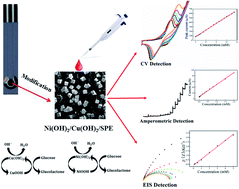Disposable non-enzymatic electrochemical glucose sensors based on screen-printed graphite macroelectrodes modified via a facile methodology with Ni, Cu, and Ni/Cu hydroxides are shown to accurately determine glucose in real human serum blood samples†
Abstract
A three dimensional (3D) non-enzymatic glucose disposable electrochemical sensor based on screen-printed graphite macroelectrodes (SPEs), modified with nickel hydroxide (Ni(OH)2/SPE), copper hydroxide (Cu(OH)2/SPE) and mixed (Ni(OH)2/Cu(OH)2/SPE) microstructures were prepared by a facile and cost-effective electrochemical method for the first time. Their morphologies and structures were analyzed by scanning electron microscopy (SEM), energy-dispersive X-ray spectroscopy (EDX) and X-ray diffraction (XRD). The electrochemical performances of the modified SPEs were evaluated by cyclic voltammetry (CV), electrochemical impedance spectroscopy (EIS), and amperometric measurements. EIS experiments showed lower charge transfer resistance Rct values for the modified SPEs, calculated to be 29.24 kΩ, 22.58 kΩ, 13.27 kΩ and 36.48 kΩ for Ni(OH)2/SPE, Cu(OH)2/SPE, Ni(OH)2/Cu(OH)2/SPE, and SPE, respectively. Under optimal experimental conditions, the results reveal that CV, amperometry and EIS can be readily applied to determine glucose using all of the fabricated sensors, however in terms of an accessible and clinically relevant linear range for the electroanalytical detection of glucose, CV is preferred, where Cu(OH)2/SPE exhibits the largest linear range from 1 μM to 20 mM (R2 = 0.997). In terms of sensitivity and the detection limit however, amperometry appeared to be a better choice of technique, particularly with Ni(OH)2/Cu(OH)2/SPE which demonstrated the highest sensitivity of 2029 μA mM−1 cm−2 and the lowest detection limit of 0.2 μM (S/N = 3). Excellent selectivity was evident against common interfering species, and it was shown to be possible to obtain satisfactory results in human blood serum samples using the as-fabricated sensors. The low cost of the SPEs, the facile preparation and observed clinically relevant analytical sensitivities and limit of detections towards the sensing of glucose make these screen-printed macroelectrode based electrochemical sensing platforms promising for routine human blood serum glucose analysis.



 Please wait while we load your content...
Please wait while we load your content...